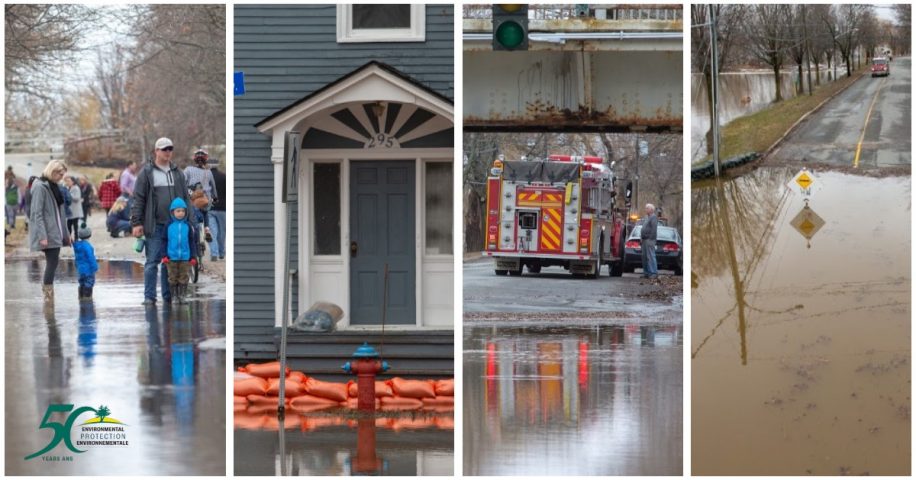Traditional Land of Wabanaki People/Fredericton – The Conservation Council of New Brunswick says a new report on the threats to Atlantic Canada from climate change serves as an urgent call to action for the provincial government to better protect people’s health, homes and livelihoods.
The Atlantic Chapter of Canada in a Changing Climate: Advancing our Knowledge for Action, was released today. Led by Natural Resources Canada, the national initiative assesses how and why Canada’s climate is changing and how it will affect our communities, people, the environment and economy.
The report paints a grim picture for New Brunswick: severe risks to infrastructure and properties from increasingly extreme flooding and coastal erosion, significant risks to people’s physical and mental health, and heightened vulnerability for the province’s forestry, agriculture and fisheries sectors, among other findings.
“New Brunswick urgently needs to develop a climate change risk assessment to rank current and future risks from climate hazards and to prioritize infrastructure (natural and traditional) and health investments that minimize those risks,” says Louise Comeau, Director of the Conservation Council’s Climate Change and Energy Solutions program.
“New Brunswick also needs to collaborate with Atlantic provinces to complete a regional climate change risk assessment so we can coordinate investments regionally that minimizes the danger of a more extreme climate. The risks to the health and safety of New Brunswickers is not being taken seriously enough by governments.”
New Brunswickers face displacement risks from deterioration of our fragile coasts and spring and winter river flooding, loss of heat and power in winter due to ice storms, challenges to food security from summer droughts, dangers of heat stroke from longer and warmer heat waves, and exposure to new pests making it harder for children to play outside.
Some key findings in the Atlantic chapter include:
- Communities, both settler and Indigenous, along the Wolastoq (St. John River), are vulnerable to contaminated overflow from sewage treatment lagoons close to the river, presenting significant health hazards;
- New Brunswickers face significant risks to mental and physical health from climate change impacts, which exacerbate existing healthcare challenges in the province (also see the Conservation Council’s 2019 report on climate change and health);
- A lack of collaboration among stakeholders within the agriculture, forestry and fisheries industries compounds the sectors’ vulnerability to climate change risks;
- In addition to amplified flood risks in coastal communities and areas prone to overland flooding and erosion, the coastline of the Northumberland Strait is particularly vulnerable given its highly erodible sandstone bedrock and the location of many low-lying communities; and,
- Coastal and overland flooding impacts infrastructure and disrupts all aspects of life and socio-economic activity, especially in particularly vulnerable locations such as the Chignecto Isthmus connecting New Brunswick to Nova Scotia, the Trans Canada Highway at Jemseg, and communities along the Kingston Peninsula that are partially or entirely reliant on ferry or bridge services.
The report also highlights that Indigenous experiences should inform adaptation efforts in the province, noting that Mi’kmaq, Wolastoqiyik and Peskotomuhkati Nations have adapted to changes in climate over countless generations and partnerships with, and leadership by, local Indigenous peoples is vital to ensure efforts benefit from their knowledge, perspective and experience.
Comeau says New Brunswick is falling behind our Atlantic neighbours in preparing for and adapting to the impacts of climate change. Prince Edward Island completed its own Climate Change Risk Assessment in 2021 and Nova Scotia is currently determining the best way to approach regional climate risk assessments, which could include the province’s capacity to prepare for and respond to impacts, the resilience of its natural systems, key groups and populations most at risk, and how best to involve citizens and other stakeholders in the process.
While pleased New Brunswick released its flood hazard mapping tool on Dec. 16, helping the public make informed decisions about home purchases and options for reducing risks, Comeau says much work remains for the Higgs Government to better protect citizen’s health, safety and livelihoods through both climate action and adaptation.
“Today’s release of the Atlantic Chapter reminds us that we must get more serious about controlling the pollution unbalancing the climate and at the same time improve our capacity to adapt to the changes in weather we can no longer avoid,” Comeau says.
-30-
To arrange an interview, contact:
Jon MacNeill, Communications Director, Conservation Council of New Brunswick | jon.macneill@conservationcouncil.ca | 506-238-3539

